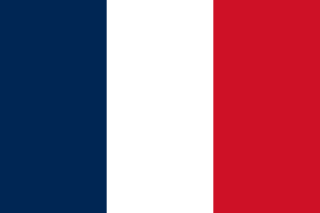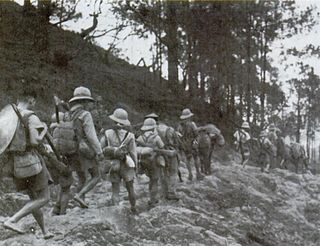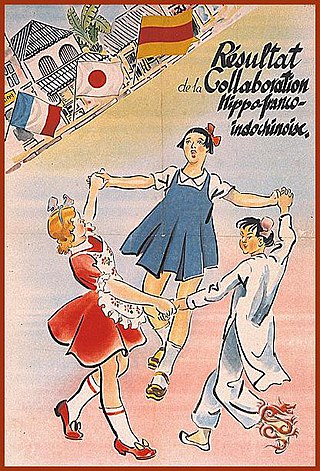
French Indochina, officially known as the Indochinese Union and after 1947 as the Indochinese Federation, was a grouping of French colonial territories in Mainland Southeast Asia until its demise in 1954. It comprised Cambodia, Laos, the Chinese territory of Guangzhouwan, and the Vietnamese regions of Tonkin in the north, Annam in the centre, and Cochinchina in the south. The capital for most of its history (1902–1945) was Hanoi; Saigon was the capital from 1887 to 1902 and again from 1945 to 1954.

The Việt Minh was a national independence coalition formed at Pác Bó by Hồ Chí Minh on 19 May 1941. Also known as the Việt Minh Front, it was created by the Indochinese Communist Party (ICP) as a national united front to achieve the independence of the Democratic Republic of Vietnam.

The First Indochina War was fought between France and Việt Minh, and their respective allies, from 19 December 1946 until 20 July 1954. Việt Minh was led by Võ Nguyên Giáp and Hồ Chí Minh. Most of the fighting took place in Tonkin in Northern Vietnam, although the conflict engulfed the entire country and also extended into the neighboring French Indochina protectorates of Laos and Cambodia.

The August Revolution, also known as the August General Uprising, was a revolution launched by the Việt Minh against the Empire of Vietnam and the Empire of Japan in the latter half of August 1945. The Việt Minh, led by the Indochinese Communist Party, was created in 1941 and designed to appeal to a wider population than what the communists could command.
The Indochina Wars were a series of wars which were waged in Indochina from 1945 to 1991, by communist forces against the opponents. The term "Indochina" referred to former French Indochina, which included the current states of Vietnam, Laos, and Cambodia. In current usage, it applies largely to a geographic region, rather than to a political area. The wars included:
The Three Alls policy was a Japanese scorched earth policy adopted in northeast China and Vietnam during World War II, the three "alls" being "kill all, burn all, loot all". This policy was designed as retaliation against the Chinese for the Communist-led Hundred Regiments Offensive in December 1940.

French Cochinchina was a colony of French Indochina, encompassing the whole region of Lower Cochinchina or Southern Vietnam from 1862 to 1946. The French operated a plantation economy whose primary strategic product was rubber.

The Empire of Vietnam was a short-lived puppet state of Imperial Japan governing the former French protectorates of Annam and Tonkin between March 11 and August 25, 1945. At the end of its rule, the empire also successfully reclaimed Cochinchina as part of Vietnam.

The Japanese invasion of French Indochina was a short undeclared military confrontation between Japan and Vichy France in northern French Indochina. Fighting lasted from 22 to 26 September 1940; the same time as the Battle of South Guangxi in the Sino-Japanese War, which was the main objective as to why Japan occupied Vietnam during this time.

The Japanese coup d'état in French Indochina, known as Meigō Sakusen, was a Japanese operation that took place on 9 March 1945, towards the end of World War II. With Japanese forces losing the war and the threat of an Allied invasion of Indochina imminent, the Japanese were concerned about an uprising against them by French colonial forces.

Trần Trọng Kim, courtesy name Lệ Thần, was a Vietnamese scholar and politician who served as the Prime Minister of the short-lived Empire of Vietnam, a state established with the support of Imperial Japan in 1945 after Japan had seized direct control of Vietnam from Vichy France toward the end of World War II. He was an uncle of Bùi Diễm.

From 1944 to 1945, during the final stage of World War II, the Allies undertook the strategic bombing of South-East Asia. The main targets of Allied air raids were Thailand and Japanese-occupied Indochina.

North Vietnam, officially the Democratic Republic of Vietnam, was a socialist state in Southeast Asia that existed from 1945 to 1976, with formal sovereignty being fully recognized in 1954. A member of the Eastern Bloc, it opposed the French-backed State of Vietnam and later the Western-allied Republic of Vietnam. North Vietnam emerged victorious over South Vietnam in 1975 and ceased to exist the following year when it unified with the south to become the current Socialist Republic of Vietnam.
The Japanese occupation of Cambodia was the period of Cambodian history during World War II when the Kingdom of Cambodia was occupied by the Japanese. Vichy France, who were a client state of Nazi Germany, nominally maintained the French protectorate over Cambodia and other parts of Indochina during most of the Japanese occupation. This territory of Cambodia was reduced, by concessions to Thailand after the Franco-Thai War, so that it did not include Stung Treng Province, Battambang Province, and Siem Reap Province.

The 1945–46 War in Vietnam, codenamed Operation Masterdom by the British, and also known as the Southern Resistance War by the Vietnamese, was a post–World War II armed conflict involving a largely British-Indian and French task force and Japanese troops from the Southern Expeditionary Army Group, versus the Vietnamese communist movement, the Viet Minh, for control of the southern half of the country, after the unconditional Japanese surrender.

In mid-1940, Nazi Germany rapidly defeated the French Third Republic, and the colonial administration of French Indochina passed to the French State. Many concessions were granted to the Empire of Japan, such as the use of ports, airfields, and railroads. Japanese troops first entered parts of Indochina in September 1940, and by July 1941 Japan had extended its control over the whole of French Indochina. The United States, concerned by Japanese expansion, started putting embargoes on exports of steel and oil to Japan from July 1940. The desire to escape these embargoes and to become self-sufficient in resources ultimately contributed to Japan's decision to attack on December 7, 1941, the British Empire and simultaneously the USA. This led to the USA declaring war against Japan on December 8, 1941. The US then joined the side of the British Empire, at war with Germany since 1939, and its existing allies in the fight against the Axis powers.

Archimedes Leonidas Attilio Patti was a lieutenant colonel in the United States Army and an Office of Strategic Services officer who headed operations in Kunming and Hanoi in 1945 when he was a Major. Patti is known for having worked closely with Hồ Chí Minh and the Việt Minh, this before and after Ho became President of the Provisional Government of the Democratic Republic of Vietnam in 1945.

Joseph-Jules Brévié was a French colonial administrator who became governor-general of French West Africa from 1930 to 1936, and then governor-general of French Indochina from 1937 to 1939. He promoted liberal and humanistic policies, and thought it important to have deep understanding of the local people and respect for their civilization. He saw the role of the administration as being the economic and human development of the people. During World War II (1939–1945) he was Minister of Overseas France and the Colonies from April 1942 to March 1943. As a result of his participation in the Vichy government he was deprived of his rank and pension after the war.

1940—1946 in French Indochina focuses on events that happened in French Indochina during and after World War II and which influenced the eventual decision for military intervention by the United States in the Vietnam War. French Indochina in the 1940s was divided into four protectorates and one colony (Cochinchina). The latter three territorial divisions made up Vietnam. In 1940, the French controlled 23 million Vietnamese with 12,000 French soldiers, about 40,000 Vietnamese soldiers, and the Sûreté, a powerful police force. At that time, the U.S. had little interest in Vietnam or French Indochina as a whole. Fewer than 100 Americans, mostly missionaries, lived in Vietnam and U.S. government representation consisted of one consul resident in Saigon.

The French Permanent Military Tribunal in Saigon, also known as Saigon Trials was a war crimes tribunal which held 39 separate trials against suspected Japanese war criminals between October 1946 and March 1950. Its scope was limited to war crimes committed against the French population of French Indochina after the Japanese coup d'état in French Indochina. Shifts in French foreign policy during the Cold War and disruptions caused by the First Indochina War caused the number of convictions to dwindle as judges opted to discontinue criminal charges against the defendants or commuted their sentences.





















